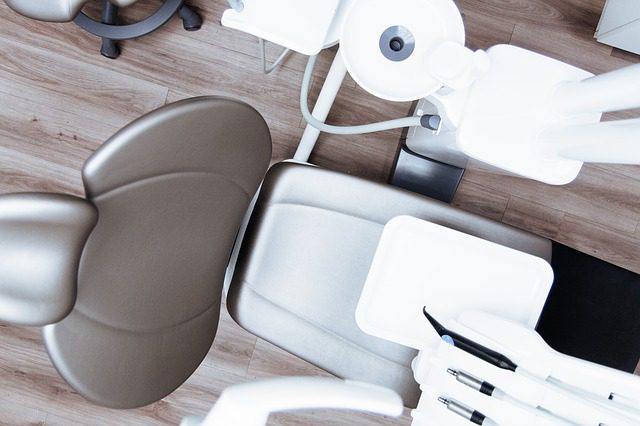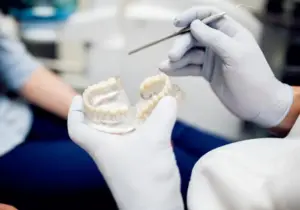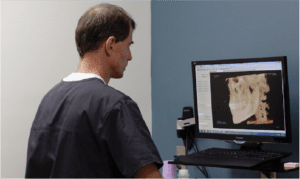Dental bone grafting is a process where an oral or maxillofacial surgeon adds scaffolding to an area of the jaw that is deteriorated to encourage natural bone to grow back in that area. Dental bone grafts can be made of natural or synthetic materials, and might be paired with other treatments that help speed healing, like platelet-rich-plasma injections.
What is a Dental Bone Graft?
It might sound kind of gnarly, but jaw bone grafts are pretty minor procedures; most of the work is done by your body after the oral surgeon has placed the graft at the site. It’s a little scaffold made of boney material. The idea is that your body will use it as framework to grow and fill into, creating healthier, stronger bone where there was once low density.
There are four different sources for a dental bone graft:
- Autografts: made from your own bone
- Allografts: made from donor human bone
- Xenografts: made from animal bone – usually bovine
- Alloplasts: made from a biocompatible synthetic material
At our practice, we use the Smart Dentin grinder, which takes donor teeth and processes them into a bone graft right here in the office. This holistic method of grafting the jaw bone boasts faster healing time and higher success rates.
Who Needs Jaw Bone Grafting?
Dental bone grafts are needed any time the jaw has deteriorated to a point where it’s affecting the structures and functions of the mouth and face. There are a few reasons a jawbone loses density:
- Tooth extraction/loss
- Facial trauma
- Osteoarthritis
- Gum disease
- Birth defects
One of the most common reasons for a jaw bone graft is to prepare the bone to take a dental implant. It’s also a common procedure when disease and decay have started to change the shape of your face and jaw. Dentists and oral surgeons may also choose to give a patient dental bone grafting before having dentures made.
What are the Risks of a Dental Bone Graft Failing?
The great thing about grafting the jaw is it doesn’t come with risk of necrosis from rejection, as the boney material used is innocuous to the immune system, referred to as biocompatibility. While the risks you run with any oral surgery are present, such as blood clots, bleeding, nerve damage, swelling, and infection, dental bone grafting is a safe and simple procedure. The main risk is if the graft fails to take hold.
There are people who will have a harder time healing from a jaw bone graft, as well as lifestyle choices that make it more likely the graft will fail to take:
- Heart conditions
- Arthritis
- Poor immune system/autoimmune conditions
- Obesity
- Diabetes
- Tobacco use before, during and/or after the grafting procedure
- Alcohol consumption in the first 2 weeks of healing
- Strenuous physical activity in the first 2 weeks of healing
- Eating hot/cold foods the first week of healing
Dental bone grafts are a type of oral surgery that requires anesthesia, so people with health issues that affect anesthesia risk also may have a harder time.
What Kinds of Jaw Bone Grafting are There?
Another advantage of bone grafts of this nature is their versatility. Generally, there are four types of bone grafts oral surgeons perform:
- Periodontal bone graft: Advanced gum disease can eat away at your jaw bone. These grafts are placed at sites of bone erosion to repair the damage caused by gum disease.
- Ridge augmentation: Jaw bone grafts can reconstruct the jaw’s ridge in preparation for mouth restoration such as dental implant surgery or denture fitting.
- Sinus lift: Your sinuses can prolapse if your upper back teeth have been missing for a while allowing your jaw to become weak and shrunken. It would be dangerous to put a dental implant back there and risk puncturing the sinus membrane, so oral surgeons will use bone grafts to put the sinuses back where they belong.
- Socket preservation: This type of dental graft is done directly after a tooth extraction. It fills the empty socket, which prevents jaw bone loss and stops other teeth from moving towards the empty socket.
As such a simple type of maxillofacial procedure, dental bone grafting proves a useful tool in oral reconstruction of all kinds, as it’s a holistic method for replacing lost bone in the mouth in a permanent way. And it’s nothing to be scared of, especially with the Smart Dentin method. It’s a real quick in and out procedure that can completely change what kind of tooth replacement is possible for a patient.









